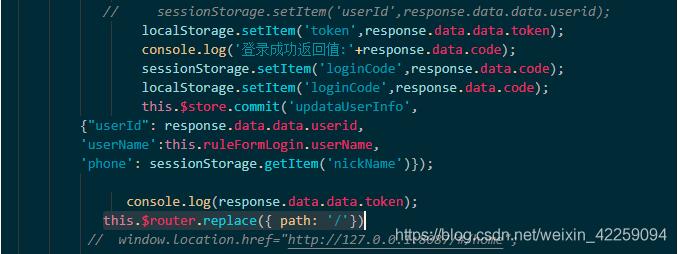Vue頁面跳轉傳遞參數及接收方式
最近接觸了vue項目,這里記錄一下vue跳轉到下一頁面攜帶參數的兩種方式。
典型應用場景:列表頁跳轉到詳情頁
一、配置路由
文件路徑:src/router/config.php
import Vue from ’vue’import Router from ’vue-router’ import classify from ’.././components/classify/classify.vue’ import classifyChild from ’.././components/classify/classifyChild.vue’ export default new Router({ mode: ’history’, routes: [ { path: ’/classify’, name: ’ classify’, component: classify }, { path: ’/classify/classifyChild’, name: ’classifyChild’, component: classifyChild }, ]})
二、頁面跳轉及傳參
//方式一<router-link :to='{name:’classifyChild’,params:{id:item.id}}'> <button>跳轉</button></router-link> //方式二<router-link :to='{path:’/classify/classifyChild’,query:{id:item.id}}'> <button>跳轉</button></router-link>
三、參數接收
//對應于方式一let id=this.$route.params.id; //對應于方式二let id=this.$route.query.id;
補充知識:關于vue3.0中的this.$router.replace({ path: ’/’})刷新無效果問題
首先在store中定義所需要的變量可以進行初始化,再定義一個方法,登錄成功后A頁面,跳轉到B頁面之前,需要直接調用store中存儲數據的方法,全局可以使用,順序是,先調用store中的數據,其次調用sessionStorage和localStorage中的數據。
這樣的話,可以避免A頁面跳轉B頁面時候,手動刷新才顯示信息。
直接登錄成功后,直接調用store的方法,把值存儲進去,B頁面可以直接顯示用戶信息。必須在store定義方法,登錄成功后調用方法進行回顯用戶信息。在這里插入圖片描述

如此一來,就可以避免必須手動刷新一下才會顯示信息。
以上這篇Vue頁面跳轉傳遞參數及接收方式就是小編分享給大家的全部內容了,希望能給大家一個參考,也希望大家多多支持好吧啦網。
相關文章:

 網公網安備
網公網安備